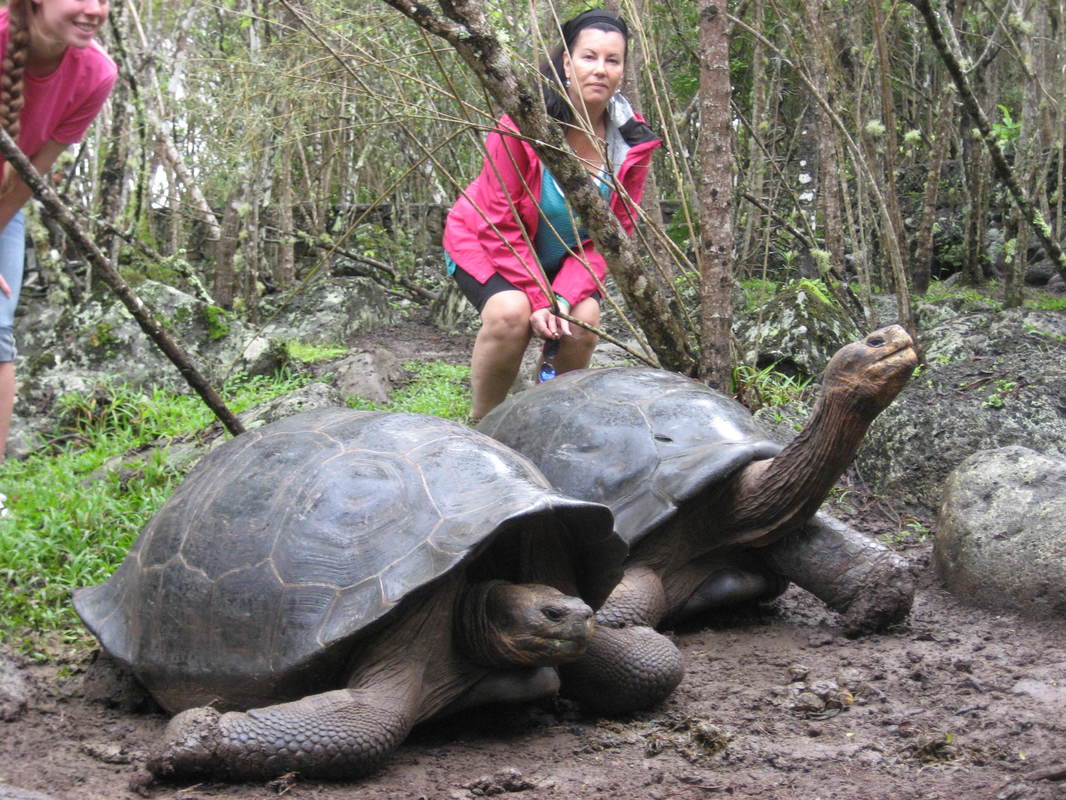|
I recently traveled to the Galapagos Islands to visit the famous Galapagos Tortoise in its indigenous habitat. I was not disappointed. The Galapagos Islands are approximately 600 miles west of Ecuador in South America. The islands were made famous by Charles Darwin who first discovered the numerous species of animals that evolved on the islands separately from similar species that evolved on mainland South and Central America. It is here that Darwin developed his famous theory of evolution through natural selection. Arrival of the Giant Galapagos TortoiseOne of the most famous of animals that evolved separately on the Galapagos Islands the famous giant Galapagos tortoise. The Galapagos Islands were first named in late 16th century, “Insulae de los Galopegos” (Islands of the Tortoises) in reference to the giant tortoises found there. It is theorized that tortoises originally arrived on the Galapagos Islands from mainland South America by rafting on floating debris such trees, and brush that was blown into the ocean and then floated by ocean currents. Upon arrival to these uninhabited islands, the tortoises survived on the lush vegetation and thrived for many years with virtually no predators. Other species of animals such as iguanas also likely rafted their way to the islands. The famous Darwin Finches and other bird species arrived through flight, but there were no predators to tortoises and they produced a thriving population with individuals growing to gigantic proportions. (They have been known to weigh up to 250 kg (550 lbs) and live up to 120 years). The giant Galapagos tortoise flourished until humans arrived. Human Arrival to the Galapagos Islands The first human that discovered the Galapagos Islands was a Spanish priest Tomas de Berlanga in 1535 when he was sailing from Panama to Peru. His ship was blown off-course during a storm and the giant tortoise secret was out. From that point onward the islands were used by pirates, sailors and whalers as a refuge, and resting place where they would search for fresh water and food. One can only imagine their delight upon seeing these giant tortoises in huge numbers inhabiting the islands. These humans quickly exploited the slow moving Galapagos Tortoise as a food source. They found the tortoises could be flipped upside-down and stored live on-board a ship for as long as a year before they died. This made the tortoises extremely vulnerable as their numbers dropped dramatically, and were pushed to the brink of extinction.  Giant Galapagos Tortoises-with a scale! Even after the mass killings of tortoises ended, the giant Galapagos Tortoise still faced extraordinary predators and competition. Humans populated the islands and brought with them domesticated animals like dogs, cats, cattle, goats and pests such as rats and mice. Today these animals threaten the Galapagos Tortoise as they eat tortoise eggs and compete for the luscious vegetation that is their food. Ecuador’s ProtectionThe country of Ecuador annexed the Galapagos Islands in 1831 and they were turned into a national park and protected refuge. Part of the protected refuge has been turned into a successful breeding center. Eggs laid by female tortoises are taken from the wild, protected, incubated, hatched and then kept within a walled breeding center until they are large enough (5 years old) to be returned to the wild on various islands. Below are some pictures from the breeding center. They are working diligently at restoring the Galapagos tortoises to their once great populations before humans arrived. Today Ecuador aggressively controls and protects all the indigenous species that are on the islands. All of our baggage and even carry-on bags were sprayed to eradicate any possible insects that may be inadvertently carried onto the islands. Upon our arrival to the Galapagos Islands, we got off the airplane, and then immediately walked over wet cleaning pads to ensure that we were not carrying any soil, mud attached to our shoes and with it, any seeds or insect larva that could be brought to the islands. They are extremely careful to avoid any further infestations that could upset the fragile island environment. For more information check out Galapagos Giant Tortoise Conservancy. During our recent trip, we were escorted by expertly trained and educated guides on controlled tours. The guides were very well informed and spoke English very well. The trip was fantastic and I would highly recommend anyone who enjoys nature as well as hiking, young and old, to visit the great Galapagos Islands and their exquisite wildlife and especially the giant Galapagos Tortoise. It’s a trip you’ll never forget.
Maddalena Environmental Inc. Al Maddalena |
